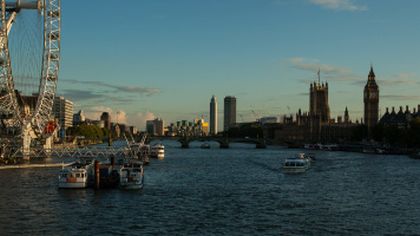
HD VERSION (1920 x 1080 px)
River Thames hyperlapse late afternoon. Camera moves across the Millennium Bridge and pans from the Houses of Parliament to the London Eye. 12 seconds
![]()
Watermarked preview version – purchased downloads have no watermark
To buy the 4K (4096 x 2304 px) version click here
To buy the Web (320 x 180 px) version click here
For a watermarked preview click here and use the download link
More about the Houses of Parliament –
The Palace of Westminster is the meeting place of the House of Commons and the House of Lords, the two houses of the Parliament of the United Kingdom. Commonly known as the Houses of Parliament after its occupants, the Palace lies on the Middlesex bank of the River Thames in the City of Westminster, in central London. Its name, which derives from the neighbouring Westminster Abbey, may refer to either of two structures: the Old Palace, a medieval building complex that was destroyed by fire in 1834, and its replacement, the New Palace that stands today. For ceremonial purposes, the palace retains its original style and status as a royal residence and is the property of the Crown.
The first royal palace was built on the site in the eleventh century, and Westminster was the primary residence of the Kings of England until a fire destroyed much of the complex in 1512. After that, it served as the home of the Parliament of England, which had been meeting there since the thirteenth century, and also as the seat of the Royal Courts of Justice, based in and around Westminster Hall. In 1834, an even greater fire ravaged the heavily rebuilt Houses of Parliament, and the only medieval structures of significance to survive were Westminster Hall, the Cloisters of St Stephen’s, the Chapel of St Mary Undercroft, and the Jewel Tower.
The subsequent competition for the reconstruction of the Palace was won by the architect Charles Barry, whose design was for new buildings in the Perpendicular Gothic style. The remains of the Old Palace (with the exception of the detached Jewel Tower) were incorporated into its much larger replacement, which contains over 1,100 rooms organised symmetrically around two series of courtyards. Part of the New Palace’s area of 3.24 hectares (8 acres) was reclaimed from the Thames, which is the setting of its principal façade, called the 266-metre (873 ft) River Front. Barry was assisted by Augustus W. N. Pugin, a leading authority on Gothic architecture and style, who provided designs for the decorations and furnishings of the Palace. Construction started in 1840 and lasted for thirty years, suffering great delays and cost overruns, as well as the death of both leading architects; works for the interior decoration continued intermittently well into the twentieth century. Major conservation work has been carried out since, to reverse the effects of London’s air pollution, and extensive repairs took place after the Second World War, including the reconstruction of the Commons Chamber following its bombing in 1941.
The Palace is one of the centres of political life in the United Kingdom; “Westminster” has become a metonym for the UK Parliament, and the Westminster system of government has taken its name after it. The Elizabeth Tower, in particular, which is often referred to by the name of its main bell, “Big Ben”, is an iconic landmark of London and the United Kingdom in general, one of the most popular tourist attractions in the city and an emblem of parliamentary democracy. The Palace of Westminster has been a Grade I listed building since 1970 and part of a UNESCO World Heritage Site since 1987.
More about The London Eye –
The London Eye is a giant Ferris wheel on the South Bank of the River Thames in London. Also known as the Millennium Wheel, its official name was originally published as the British Airways London Eye, then the Merlin Entertainments London Eye, then the EDF Energy London Eye. Since mid-January 2015, it has been known in branding as the Coca-Cola London Eye, following an agreement signed in September 2014.
The entire structure is 135 metres (443 ft) tall and the wheel has a diameter of 120 metres (394 ft). When erected in 1999 it was the world’s tallest Ferris wheel. Its height was surpassed by the 160 m (520 ft) Star of Nanchang in 2006, the 165 m (541 ft) Singapore Flyer in 2008, and the 167.6 m (550 ft) High Roller (Las Vegas) in 2014. Supported by an A-frame on one side only, unlike the taller Nanchang and Singapore wheels, the Eye is described by its operators as “the world’s tallest cantilevered observation wheel”.
It is currently Europe’s tallest Ferris wheel, and offered the highest public viewing point in London until it was superseded by the 245-metre (804 ft) observation deck on the 72nd floor of The Shard, which opened to the public on 1 February 2013. It is the most popular paid tourist attraction in the United Kingdom with over 3.5 million visitors annually, and has made many appearances in popular culture.
The London Eye adjoins the western end of Jubilee Gardens (previously the site of the former Dome of Discovery), on the South Bank of the River Thames between Westminster Bridge and Hungerford Bridge, in the London Borough of Lambeth.

